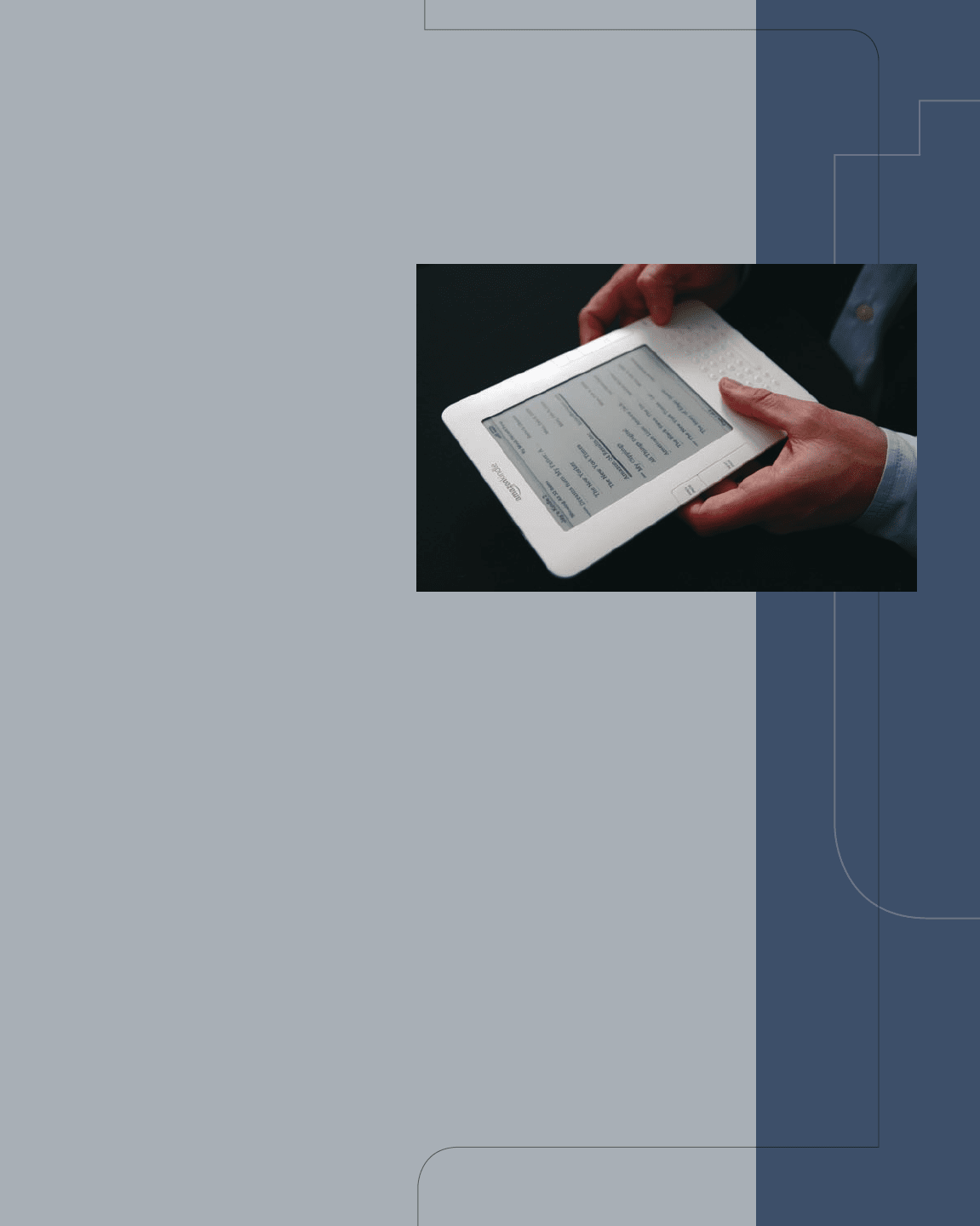Hitt M.A., Ireland R.D., Hoskisson R.E. Strategic Management: Competitiveness and Globalization: Concepts
Подождите немного. Документ загружается.


Studying this chapter should provide you with the strategic
management knowledge needed to:
1. Defi ne strategic entrepreneurship and corporate entrepreneurship.
2. Defi ne entrepreneurship and entrepreneurial opportunities and explain
their importance.
3. Defi ne invention, innovation, and imitation, and describe the relationship
among them.
4. Describe entrepreneurs and the entrepreneurial mind-set.
5. Explain international entrepreneurship and its importance.
6. Describe how fi rms internally develop innovations.
7. Explain how fi rms use cooperative strategies to innovate.
8. Describe how fi rms use acquisitions as a means of innovation.
9. Explain how strategic entrepreneurship helps fi rms create value.
s
chapter should provide
y
ou with the strate
g
ic
t
k
now
l
e
d
ge nee
d
e
d
to:
a
tegic entrepreneurship and corporate entrepreneurship.
t
r
ep
reneurship and entre
pr
eneurial o
pp
ortunities and e
xp
lain
o
rtance
.
e
ntion, innovation, and imitation, and describe the relationship
e
m
.
e
ntre
p
reneurs and the entre
p
reneurial mind-set.
t
ernational entre
p
reneurshi
p
and its im
p
ortance
.
CHAPTER 13
Strategic
Entrepreneurship

Jeff Bezos led the Internet retailing revolution
with his entry into the book retail market
in 1995. Since that time, Amazon.com has
signifi cantly expanded its product lines and
implemented several innovations, especially in
processes and approaches to marketing their products. Recently, Bezos and Amazon are
leading a potential revolution in the book market with the Kindle, which provides easy access
to store and read many e-books. Let’s be clear—Amazon did not create the digital book.
E-books have been available for several years, but access to and use of e-books has not been
necessarily easy. But, with the development of the Kindle e-reader, access to and ease of
reading e-books has been simplifi ed and it is predicted to revolutionize the book publishing
business within the next fi ve years.
The Kindle was fi rst introduced in
2007, and two newer and improved
versions were introduced in 2009. The
Kindle 2 was introduced in February
2009 and according to market analysts,
it literally “fl ew off the shelves” at a
time when consumers were curtailing
purchases of most other products. Then
in May 2009, Amazon introduced a
large-screen version of the Kindle 2, the
Kindle DX, which has a 9.7-inch screen.
While the DX appears to be a little
cumbersome, it provides larger screen
access to graphics-heavy publications
common in college textbooks. The Kindle
currently can be used to download any of
the 285,000 e-books available in
Amazon’s inventory. Amazon’s new
Kindles are thinner than a pencil and
offer a feature allowing text to be
translated into voice. This means that
it can read to you! Bezos demonstrated this feature at the introduction by having the
computer-generated voice read the Gettysburg Address.
Amazon’s success in the fi rst quarter of 2009 (e.g., a 24 percent increase in earnings
from the fi rst quarter 2008) was largely attributed to the Kindle. It is predicted to be wildly
successful. Barclays Capital has predicted that it will reach annual sales of $3.7 billion in
2012 with a profi t of $840 million. This amount would account for approximately 20 percent
of Amazon’s predicted sales that year. Amazon also earns a return by selling content for use
on the Kindle in the form of e-books and other electronic content. For example, Amazon
sells subscriptions to 37 different newspapers for the Kindle at $10 per month. This set
includes such respected newspapers as the New York Times, Boston Globe, and Washington
Post. It also has an agreement for a pilot program at fi ve major universities, hoping that
students will soon be carrying all of their textbooks on the Kindle in their backpacks.
Clearly, Amazon’s biggest potential challenge may come from competitors. The Kindle
technology is likely imitable and Sony already has a competitor e-reader on the market.
Thus, Amazon must entrench the Kindle quickly and continue to enrich its features (the
Kindle currently only provides “black-and-white” content even though it is said to provide
better resolution than can be obtained in print copies). While the Kindle may help Amazon
become the Apple of the e-reader market, the Kindle is likely to revolutionize all publishing
industries (e.g., book publishers, newspapers).
Sources: S. Stein, 2009, Old, real book vs. Kindle alternative: Which will win? CNET.com, http://www.cnet.com,
June 12; J. M. O’Brien, 2009, Amazon’s next revolution, Fortune, June 8, 68–76; B. Stone & M. Rich, 2009,
Amazon introduces big-screen Kindle, New York Times, http://www.nytimes.com, May 7; D. MacMillan, 2009,
Amazon’s widescreen Kindle DX: Winners and losers, BusinessWeek, http://businessweek.com, May 7; C.
Dannen, 2009, Amazon CEO Jeff Bezos unveils Kindle DX in New York, Fast Company, http://www.fastcompany.
com, May 6; D. Darlin, 2009, First impressions of the new Kindle DX, New York Times, http://www.gadgetwise.
blogs.nytimes.com, May 6; C. Gallo, 2009, How Amazon’s Bezos sparked demand for Kindle 2, BusinessWeek,
http://businessweek.com, February, 24.
THE CONTINUING
INNOVATION REVOLUTION
AT AMAZON: THE
KINDLE AND E-BOOKS
The new Kindle 2 electronic reader “flew off the
shelves” at a time when consumers were curtailing
purchases of most other products.
AP Photo/Mark Lennihan

380
Part 3: Strategic Actions: Strategy Implementation
In Chapter 1, we indicated that organizational culture refers to the complex set of ideologies,
symbols, and core values that are shared throughout the firm and that influence how the
firm conducts business. Thus, culture is the social energy that drives—or fails to drive—
the organization. The Opening Case explains Amazon’s new innovation, the Kindle,
that is expected to revolutionize the publishing industries (any businesses which provide
products printed with ink on paper). Increasingly, a firm’s ability to engage in innovation
makes the difference in gaining and maintaining a competitive advantage and achieving
performance targets.
1
Amazon is clearly an entrepreneurial and innovative company. Amazon is the lead-
ing Internet retailer in the world and also consistently produces innovations. Not all of
them are successful, but the Kindle appears to be on the verge of being highly successful.
From reading this chapter, you will understand that Amazon’s ability to innovate shows
that it successfully practices strategic entrepreneurship.
Strategic entrepreneurship is taking entrepreneurial actions using a strategic per-
spective. In this process, the firm tries to find opportunities in its external environ-
ment that it can try to exploit through innovations. Identifying opportunities to exploit
through innovations is the entrepreneurship dimension of strategic entrepreneurship,
while determining the best way to manage the firm’s innovation efforts is the strategic
dimension. Thus, firms engaging in strategic entrepreneurship integrate their actions
to find opportunities and to successfully innovate in order to pursue them.
2
In the
twenty-first–century competitive landscape, firm survival and success depend on a
firm’s ability to continuously find new opportunities and quickly produce innovations to
pursue them.
3
To examine strategic entrepreneurship, we consider several topics in this chapter.
First, we examine entrepreneurship and innovation in a strategic context. Definitions
of entrepreneurship, entrepreneurial opportunities, and entrepreneurs as those who
engage in entrepreneurship to pursue entrepreneurial opportunities are presented. We
then describe international entrepreneurship, a phenomenon reflecting the increased
use of entrepreneurship in economies throughout the world. After this discussion,
the chapter shifts to descriptions of the three ways firms innovate. Internally, firms
innovate through either autonomous or induced strategic behavior. We then describe
actions firms take to implement the innovations resulting from those two types of
strategic behaviors.
In addition to innovating within the firm, firms can develop innovations by using
cooperative strategies, such as strategic alliances, and by acquiring other companies to
gain access to their innovations and innovative capabilities.
4
Most large, complex firms
use all three methods to innovate. The chapter closes with summary comments about how
firms use strategic entrepreneurship to create value and earn above-average returns.
As emphasized in this chapter, innovation and entrepreneurship are vital for young
and old and for large and small firms, for service companies as well as manufacturing
firms, and for high-technology ventures.
5
In the global competitive landscape, the long-
term success of new ventures and established firms is a function of their ability to meld
entrepreneurship with strategic management.
6
A major portion of the material in this chapter is on innovation and entrepreneur-
ship within established organizations. This phenomenon is called corporate entre-
preneurship
, which is the use or application of entrepreneurship within an established
firm.
7
Corporate entrepreneurship has become critical to the survival and success of
established organizations.
8
Indeed, established firms use entrepreneurship to strengthen
their performance and to enhance growth opportunities.
9
Of course, innovation and
entrepreneurship play a critical role in the degree of success achieved by startup entre-
preneurial ventures as well. Much of the content examined in this chapter is equally
important in entrepreneurial ventures (sometimes called “startups”) and established
organizations.
10
380
Strategic
entrepreneurship
is
taking entrepreneurial
actions using a strategic
perspective.
Corporate
entrepreneurship is
the use or application of
entrepreneurship within an
established fi rm.

381
Chapter 13: Strategic Entrepreneurship
Entrepreneurship and Entrepreneurial
Opportunities
Entrepreneurship is the process by which individuals, teams, or organizations identify
and pursue entrepreneurial opportunities without being immediately constrained by
the resources they currently control.
11
Entrepreneurial opportunities are conditions in
which new goods or services can satisfy a need in the market. These opportunities exist
because of competitive imperfections in markets and among the factors of production
used to produce them or because they were independently developed by entrepreneurs.
12
Entrepreneurial opportunities come in many forms such as the chance to develop and
sell a new product and the chance to sell an existing product in a new market.
13
Firms
should be receptive to pursuing entrepreneurial opportunities whenever and wherever
they may surface.
14
As these two definitions suggest, the essence of entrepreneurship is to identify and
exploit entrepreneurial opportunities—that is, opportunities others do not see or for
which they do not recognize the commercial potential.
15
As a process, entrepreneurship
results in the “creative destruction” of existing products (goods or services) or methods
of producing them and replaces them with new products and production methods.
16
Thus, firms engaging in entrepreneurship place high value on individual innovations as
well as the ability to continuously innovate across time.
17
We study entrepreneurship at the level of the individual firm. However, evidence
suggests that entrepreneurship is the economic engine driving many nations’ econo-
mies in the global competitive landscape.
18
Thus, entrepreneurship, and the innovation it
spawns, is important for companies competing in the global economy and for countries
seeking to stimulate economic climates with the potential to enhance the living standard
of their citizens.
19
A recent study conducted by the Boston Consulting Group and the
Small Business Division of Intuit found that 10 million people in the United States were
considering starting a new business. About one-third of those who do will expand into
international markets. The study suggested that by 2017 the number of entrepreneurs
will increase, and the entrepreneurs will be younger and include more women and immi-
grants. Thus, even though the importance of entrepreneurship continues to grow, the
“face” of those who start new ventures is also changing.
20
Innovation
Peter Drucker argued that “innovation is the specific function of entrepreneurship,
whether in an existing business, a public service institution, or a new venture started
by a lone individual.”
21
Moreover, Drucker suggested that innovation is “the means by
which the entrepreneur either creates new wealth-producing resources or endows exist-
ing resources with enhanced potential for creating wealth.”
22
Thus, entrepreneurship
and the innovation resulting from it are critically important for all firms. The realities
of competition in the competitive landscape of the twenty-first century suggest that to
be market leaders, companies must regularly develop innovative products desired by
customers. This means that innovation should be an intrinsic part of virtually all of a
firm’s activities.
23
Innovation is a key outcome firms seek through entrepreneurship and is often the
source of competitive success, especially in turbulent, highly competitive environments.
24
For example, research results show that firms competing in global industries that invest
more in innovation also achieve the highest returns.
25
In fact, investors often react posi-
tively to the introduction of a new product, thereby increasing the price of a firm’s stock.
Furthermore, “innovation may be required to maintain or achieve competitive parity,
Entrepreneurship is
the process by which
individuals, teams,
or organizations
identify and pursue
entrepreneurial
opportunities without
being immediately
constrained by
the resources they
currently control.
Entrepreneurial
opportunities
are
conditions in which
new goods or services
can satisfy a need in
the market.

382
much less a competitive advantage in many global markets.”
26
Investing in the develop-
ment of new technologies can increase the performance of firms that operate in different
but related product markets (refer to the discussion of related diversification in Chapter
6). In this way, the innovations can be used in multiple markets, and return on the invest-
ments is earned more quickly.
27
In his classic work, Schumpeter argued that firms engage in three types of innovative
activities.
28
Invention is the act of creating or developing a new product or process.
Innovation is the process of creating a commercial product from an invention.
Innovation begins after an invention is chosen for development.
29
Thus, an invention
brings something new into being, while an innovation brings something new into use.
Accordingly, technical criteria are used to determine the success of an invention, whereas
commercial criteria are used to determine the success of an innovation.
30
Finally, imitation
is the adoption of a similar innovation by different firms. Imitation usually leads to
product or process standardization, and products based on imitation often are offered
at lower prices, but without as many features. Entrepreneurship is critical to innovative
activity in that it acts as the linchpin between invention and innovation.
31
In the United States in particular, innovation is the most critical of the three types
of innovative activities. Many companies are able to create ideas that lead to inventions,
but commercializing those inventions has, at times, proved difficult.
32
This difficulty is
suggested by the fact that approximately 80 percent of R&D occurs in large firms, but
these same firms produce fewer than 50 percent of the patents.
33
Patents are a strategic
asset and the ability to regularly produce them can be an important source of competi-
tive advantage, especially for firms competing in knowledge-intensive industries (e.g.,
pharmaceuticals).
34
Entrepreneurs
Entrepreneurs are individuals, acting independently or as part of an organization, who
perceive an entrepreneurial opportunity and then take risks to develop an innovation
to pursue it. Entrepreneurs can be found throughout an organization—from top-level
managers to those working to produce a firm’s goods or services. Entrepreneurs are
found throughout Amazon, for example. Many Amazon employees must devote at least
a portion of their time to develop innovations. Entrepreneurs tend to demonstrate sev-
eral characteristics: They are highly motivated, willing to take responsibility for their
projects, self-confident, and often optimistic.
35
In addition, entrepreneurs tend to be pas-
sionate and emotional about the value and importance of their innovation-based ideas.
36
They are able to deal with uncertainty and are more alert to opportunities than others.
37
Interestingly, recent research found that genetic factors partly influence people to engage
in entrepreneurship.
38
To be successful, entrepreneurs often need to have good social
skills and to plan exceptionally well (e.g., to obtain venture capital).
39
Entrepreneurship
entails much hard work to be successful but it can also be highly satisfying. As noted by
Mary Kay Ash, founder of Mary Kay Cosmetics, “It is far better to be exhausted from
success than to be rested from failure.”
40
Evidence suggests that successful entrepreneurs have an entrepreneurial mind-set.
The person with an entrepreneurial mind-set values uncertainty in the marketplace
and seeks to continuously identify opportunities with the potential to lead to important
innovations.
41
Because it has the potential to lead to continuous innovations, an indi-
vidual’s entrepreneurial mind-set can be a source of competitive advantage for a firm.
42
Entrepreneurial mind-sets are fostered and supported when knowledge is readily avail-
able throughout a firm. Indeed, research has shown that units within firms are more
innovative when they have access to new knowledge.
43
Transferring knowledge, however,
can be difficult, often because the receiving party must have adequate absorptive capacity
(or the ability) to learn the knowledge.
44
Learning requires that the new knowledge be
Invention is the act of
creating or developing a
new product or process.
Innovation is the process
of creating a commercial
product from an invention.
Imitation is the adoption
of a similar innovation by
different fi rms.
Entrepreneurs are
individuals, acting
independently or as
part of an organization,
who perceive an
entrepreneurial
opportunity and then
take risks to develop an
innovation to exploit it.
The person with an
entrepreneurial mind-
set values uncertainty
in the marketplace and
seeks to continuously
identify opportunities with
the potential to lead to
important innovations.
Part 3: Strategic Actions: Strategy Implementation

383
Chapter 13: Strategic Entrepreneurship
linked to the existing knowledge. Thus, managers need to develop the capabilities of their
human capital to build on their current knowledge base while incrementally expanding
that knowledge.
45
Some companies are known for their entrepreneurial culture. For example, in 2008
Apple was ranked as the most innovative company for the fourth year in a row. The
rest of the top 10 most innovative companies were Google, Toyota, General Electric,
Microsoft, Tata Group, Nintendo, Procter & Gamble, Sony, and Nokia. Yet, there are
other companies known as the antithesis of innovative. For example, GM was known
for sacrificing innovation for profits. Of course, this approach eventually led to GM’s
demise.
46
International Entrepreneurship
International entrepreneurship is a process in which firms creatively discover and
exploit opportunities that are outside their domestic markets in order to develop a com-
petitive advantage.
47
As the practices suggested by this definition show, entrepreneurship
is a global phenomenon.
48
As noted earlier, approximately one-third of new ventures
move into international markets early in their life cycle. Most large established compa-
nies have significant foreign operations and often start new ventures in domestic and
international markets. Large multinational companies, for example, generate approxi-
mately 54 percent of their sales outside their domestic market, and more than 50 percent
of their employees work outside of the company’s home country.
49
A key reason that entrepreneurship has become a global phenomenon is that in gen-
eral, internationalization leads to improved firm performance.
50
Nonetheless, decision
makers should recognize that the decision to internationalize exposes their firms to vari-
ous risks, including those of unstable foreign currencies, problems with market efficien-
cies, insufficient infrastructures to support businesses, and limitations on market size.
51
Thus, the decision to engage in international entrepreneurship should be a product of
careful analysis.
Because of its positive benefits, entrepreneurship is at the top of public policy
agendas in many of the world’s countries, including Finland, Ireland, Israel, and the
United States. Entrepreneurship has become a particularly important public agenda
item with the global economic crisis, which began in late 2007. For example, the U.S.
government and the Michigan state government are emphasizing entrepreneurial
activity to revitalize the Detroit area hurt seriously by the loss of jobs due to the U.S.
auto companies’ decline.
52
Even though entrepreneurship is a global phenomenon, the rate of entrepreneur-
ship differs across countries. A study of 43 countries found that the percentage of adults
involved in entrepreneurial activity ranged from a high of more than 45 percent in Bolivia
to a low of approximately 4.4 percent in Russia. The United States had a rate of almost 19
percent. Importantly, this study also found a strong positive relationship between the rate
of entrepreneurial activity and economic development in a country.
53
Culture is one of the reasons for the differences in rates of entrepreneurship among
different countries. The research suggests that a balance between individual initiative
and a spirit of cooperation and group ownership of innovation is needed to encourage
entrepreneurial behavior. For firms to be entrepreneurial, they must provide appropriate
autonomy and incentives for individual initiative to surface, but also promote coop-
eration and group ownership of an innovation if it is to be implemented successfully.
Thus, international entrepreneurship often requires teams of people with unique skills
and resources, especially in cultures that highly value individualism or collectivism. In
addition to a balance of values for individual initiative and cooperative behaviors, firms
must build the capabilities to be innovative and acquire the resources needed to support
innovative activities.
54
International
entrepreneurship is a
process in which fi rms
creatively discover and
exploit opportunities
that are outside their
domestic markets in
order to develop a
competitive advantage.

384
Part 3: Strategic Actions: Strategy Implementation
The level of investment outside of the home country made by young ventures is
also an important dimension of international entrepreneurship. In fact, with increasing
globalization, a greater number of new ventures have been “born global.”
55
Research has
shown that new ventures that enter international markets increase their learning of new
technological knowledge and thereby enhance their performance.
56
The probability of entering international markets increases when the firm has top
executives with international experience, which increases the likelihood of the firm suc-
cessfully competing in those markets.
57
Because of the learning and economies of scale
and scope afforded by operating in international markets, both young and established
internationally diversified firms often are stronger competitors in their domestic market
as well. Additionally, as research has shown, internationally diversified firms are gener-
ally more innovative.
58
As explained in the Strategic Focus, innovation has become highly important in the
global competitive landscape. Thus, the ability of firms to gain and sustain a competitive
advantage may be based partly or largely on the capability to produce innovations. Thus,
we next discuss different types of innovations.
Internal Innovation
In established organizations, most innovation comes from efforts in research and devel-
opment (R&D). Effective R&D often leads to firms’ filing for patents to protect their
innovative work. Increasingly, successful R&D results from integrating the skills avail-
able in the global workforce. Thus, the ability to have a competitive advantage based on
innovation is more likely to accrue to firms capable of integrating the talent of human
capital from countries around the world.
59
Both Intel and Nokia have been innovative firms and market leaders. In 2009, they
announced an agreement to jointly develop new mobile computing products that pro-
vide functions beyond the current smartphones and netbooks. The new products likely
will integrate features of both phones and computers. Thus, the two companies can
combine and integrate their current knowledge and capabilities of both types of products
and the markets for them. While Intel has not yet “cracked” the smartphone market with
its memory chips, Nokia has been successful with smartphones but was caught off guard
when Apple introduced its now highly popular iPhone. Therefore, the marriage between
the two should help each to overcome its weaknesses by integrating their strengths. In
addition to the development of new products from their joint R&D efforts, they also plan
to develop software for devices using the Linux operating system.
60
Increasingly, it seems possible that in the twenty-first century competitive landscape,
R&D may be the most critical factor in gaining and sustaining a competitive advantage
in some industries, such as pharmaceuticals. Larger, established firms, certainly those
competing globally, often try to use their R&D labs to create competence-destroying new
technologies and products. Being able to innovate in this manner can create a competi-
tive advantage for firms in many industries.
61
Although critical to long-term corporate
success, the outcomes of R&D investments are uncertain and often not achieved in the
short term, meaning that patience is required as firms evaluate the outcomes of their
R&D efforts.
62
Incremental and Radical Innovation
Firms produce two types of internal innovations—incremental and radical innovations—
when using their R&D activities. Most innovations are incremental—that is, they build
on existing knowledge bases and provide small improvements in the current product
lines. Incremental innovations are evolutionary and linear in nature.
63
“The markets for
incremental innovations are well-defined, product characteristics are well understood,
profit margins tend to be lower, production technologies are efficient, and competition

In 2009, the United States continued to
be ranked as the most competitive nation.
This top ranking and those of some other
developed countries are based on the quality
of infrastructures, educational systems, and
laws regarding business operations. It is also due to their advanced levels of innovation over
the years. Yet, the major economic crisis beginning in late 2007 and early 2008 has shown
some “cracks” in the economic leadership of these countries. In the twenty-first century,
economic power has begun to shift to major emerging economies such as China and India.
However, the shift may be even more fundamental, as many believe that innovation is
the most critical factor in a nation’s competitiveness over time. In fact, the United States
competitiveness is likely based on the significant innovative capabilities and innovative output
of its businesses. While certain business leaders in the United States understand the impor-
tance of innovation (e.g., members of the U.S. Council on Competitiveness), the country is no
longer ranked as the most innovative nation. In fact, the United States ranked eighth in the
2009 International Innovation Index (among the 110 countries ranked). Singapore was ranked
first. In a report issued by the Information Technology and Innovation Foundation, the United
States was ranked sixth among 40 countries and regions around the world. Singapore was
also ranked first in this report. Singapore developed
a strategy to promote specific programs by invest-
ing heavily in attracting major technologies and
recruiting top scientists to develop more innovation.
That strategy is now paying substantial dividends.
Firms based in the United States have focused too
much on producing short-term returns, leading to
an overemphasis on incremental innovations. As a
result, the country is now in danger of losing its lead
in science and technology. Perhaps one of the most
prominent examples is Exxon-Mobil, which receives
approximately $756,000 in revenue per minute.
Rather than focus on developing new sources of
energy, it seeks to enhance its ability to gain access to
and extract with greater efficiency black gold or oil.
According to a 2009 report in BusinessWeek,
technological breakthroughs in a number of fields have
been few in number since 1998 (e.g., medical science,
drugs, information technology, etc.). The leadership
in these fields is largely represented by firms based in the United States. However, future
technological breakthroughs in these fields are likely to be produced by firms based in other
countries. Regaining this lead will require a major change in mind-set, investments, and promo-
tion of entrepreneurial endeavors. Efforts have been implemented to encourage and develop
more entrepreneurial activities in a number of industries and geographic regions to stop the
economic decline and facilitate economic growth in the United States. It is unclear if these
efforts will be successful in the short or long term.
Sources: M. Mandel, 2009, Innovation interrupted, BusinessWeek, June 15, 034-040; 2009, International innovation index,
Wikipedia, http://www.answers.com, June 13; B. Ott, 2009, Top companies can tame bear markets, Yahoo News, http://www
.yahoo.com, June 11; A. S. Choi, 2009, Can entrepreneurs save this town? BusinessWeek, http://www.businessweek.com,
June 5; M. Scott, 2009, Competitiveness: The U.S. and Europe are tops, BusinessWeek, http://www.businessweek.com, May
19; M. Richtel & J. Wortham, 2009, Weary of looking for work, some create their own, New York Times, http://www.nytimes
.com, March 14; S. Lohr, 2009, In innovation, U.S. said to be losing competitive edge, New York Times, http://www.nytimes
.com, February 25; J. Rae-Dupree, 2009, Innovation should mean more jobs, not less, New York Times, http://www.nytimes
.com, January 4; R. Empson, 2008, Encouraging innovation: How can we do it better? Fast Company, http://www
. fastcompany.com, August 1.
COMPETITIVENESS
AND INNOVATION: ARE
WE EXPERIENCING A
PARADIGM SHIFT?
With forward-thinking investments in the
recruitment of top scientists and
attraction of key technologies, Singapore
is the world leader in innovation.
Corbis/PhotoLibrary

386
Part 3: Strategic Actions: Strategy Implementation
is primarily on the basis of price.”
64
Adding a different kind of whitening agent to a soap
detergent is an example of an incremental innovation, as are improvements in televisions
over the last few decades. Companies launch far more incremental innovations than
radical innovations because they are cheaper, easier and faster to produce, and involve
less risk.
65
In contrast to incremental innovations, radical innovations usually provide signifi-
cant technological breakthroughs and create new knowledge.
66
Radical innovations,
which are revolutionary and nonlinear in nature, typically use new technologies to serve
newly created markets. The development of the original personal computer (PC) was a
radical innovation at the time. Reinventing the computer by developing a “radically new
computer-brain chip” (e.g., with the capability to process a trillion calculations per sec-
ond) is an example of a radical innovation. Obviously, such a radical innovation would
seem to have the capacity to revolutionize the tasks computers could perform. Perhaps
some of the new products to be produced by the joint venture between Intel and Nokia
integrating smartphones and computers will be considered to be radical innovations.
Because they establish new functionalities for users, radical innovations have strong
potential to lead to significant growth in revenue and profits.
67
Developing new processes
is a critical part of producing radical innovations. Both types of innovations can create
value, meaning that firms should determine when it is appropriate to emphasize either
incremental or radical innovation. However, radical innovations have the potential to
contribute more significantly to a firm’s efforts to earn above-average returns.
Radical innovations are rare because of the difficulty and risk involved in developing
them. The value of the technology and the market opportunities are highly uncertain.
68
Because radical innovation creates new knowledge and uses only some or little of a firm’s
current product or technological knowledge, creativity is required. However, creativity
does not produce something from nothing. Rather, creativity discovers, combines, or
synthesizes current knowledge, often from diverse areas.
69
This knowledge is then used
to develop new products that can be used in an entrepreneurial manner to move into new
markets, capture new customers, and gain access to new resources.
70
Such innovations
are often developed in separate business units that start internal ventures.
71
Internally developed incremental and radical innovations result from deliberate
efforts. These deliberate efforts are called internal corporate venturing, which is the set
of activities firms use to develop internal inventions and especially innovations.
72
As
shown in Figure 13.1, autonomous and induced strategic behaviors are the two types
of internal corporate venturing. Each venturing type facilitates incremental and radical
innovations. However, a larger number of radical innovations spring from autonomous
strategic behavior while the greatest percentage of incremental innovations come from
induced strategic behavior.
Autonomous Strategic Behavior
Autonomous strategic behavior is a bottom-up process in which product champions pur-
sue new ideas, often through a political process, by means of which they develop and
coordinate the commercialization of a new good or service until it achieves success in the
marketplace. A product champion is an organizational member with an entrepreneurial
vision of a new good or service who seeks to create support for its commercialization.
Product champions play critical roles in moving innovations forward. Indeed, in many
corporations, “Champions are widely acknowledged as pivotal to innovation speed and
success.”
73
Champions are vital to sell the ideas to others in the organization so that the
innovations will be commercialized. Commonly, product champions use their social cap-
ital to develop informal networks within the firm. As progress is made, these networks
become more formal as a means of pushing an innovation to the point of successful com-
mercialization.
74
Internal innovations springing from autonomous strategic behavior
frequently differ from the firm’s current strategy, taking it into new markets and perhaps
new ways of creating value for customers and other stakeholders.

387
Chapter 13: Strategic Entrepreneurship
Concept of corporate strategy
Structural contextStrategic context
Autonomous
strategic
behavior
Induced
strategic
behavior
Figure 13.1 Model of Internal Corporate Venturing
Source: Adapted from R. A. Burgelman, 1983, A model of the interactions of strategic behavior, corporate context, and
the concept of strategy, Academy of Management Review, 8: 65.
Autonomous strategic behavior is based on a firm’s wellspring of knowledge and
resources that are the sources of the firm’s innovation. Thus, a firm’s technological capa-
bilities and competencies are the basis for new products and processes.
75
As described
in the Strategic Focus, Exxon-Mobil does not appear to use autonomous strategic
behavior to identify new technologies and products that can better serve its customers.
Alternatively, the iPod likely resulted from autonomous strategic behavior in Apple,
though the development of the iPhone was more the result of induced strategic behavior
discussed in the next section.
Changing the concept of corporate-level strategy through autonomous strategic
behavior results when a product is championed within strategic and structural contexts
(see Figure 13.1). Such a transformation occurred with the development of the iPod and
introduction of iTunes at Apple. The strategic context is the process used to arrive at
strategic decisions (often requiring political processes to gain acceptance). The best firms
keep changing their strategic context and strategies because of the continuous changes in
the current competitive landscape. Thus, some believe that the most competitively suc-
cessful firms reinvent their industry or develop a completely new one across time as they
compete with current and future rivals.
76
To be effective, an autonomous process for developing new products requires that
new knowledge be continuously diffused throughout the firm. In particular, the diffu-
sion of tacit knowledge is important for development of more effective new products.
77
Interestingly, some of the processes important for the promotion of autonomous new
product development behavior vary by the environment and country in which a firm
operates. For example, the Japanese culture is high on uncertainty avoidance. As such,
research has found that Japanese firms are more likely to engage in autonomous behav-
iors under conditions of low uncertainty.
78
Induced Strategic Behavior
The second of the two forms of internal corporate venturing, induced strategic behavior, is
a top-down process whereby the firm’s current strategy and structure foster innovations
that are closely associated with that strategy and structure.
79
In this form of venturing, the
strategy in place is filtered through a matching structural hierarchy. In essence, induced
strategic behavior results in internal innovations that are highly consistent with the firm’s
